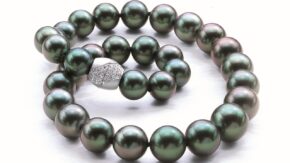Purchasing from the public comes with both risks and rewards, says Russell Fogarty, partner at estate jeweler Kazanjian & Fogarty in Beverly Hills, California.
What homework should a jeweler do?
Know the basics: the gold or platinum value of a piece, weight and grade of diamonds, identification of colored stones. Have general knowledge of the different jewelry eras, especially from 1900 forward. Learn hallmarks and signatures of important jewelers and brands. If a piece is a reproduction, it is simply worth the sum of the intrinsic parts, which is a fraction of the value of an authentic piece. If a piece seems too good to be true, go slow. If you are unsure, collaborate with experienced estate jewelry buyers. Almost daily, we are asked for our opinion of the value and authenticity of items.
What are good questions to ask a seller?
“How long have you owned the piece?” If an item was a recent purchase, you can assume there is going to be a big difference between the price paid and an offer you make. Be ready to explain why. “Was it a gift or a purchase?” Clients usually know more about a purchase than a gift. Where it was purchased can help verify authenticity. We don’t ask, “How much do you want?” which can be uncomfortable for most sellers.
How can one determine authenticity?
Authenticity is a hot-button issue because of the large number of quality fakes on the market. Fake signatures on vintage pieces are usually easier to recognize because of inferior craftsmanship, incorrect font styles or hallmarks. New jewelry today is often laser-engraved by the major brands, which makes it even easier to fake a signature. For that reason, we no longer purchase Cartier Love bracelets or Van Cleef & Arpels Alhambra jewels unless we know the client, or the seller has a receipt of purchase. When we resell an item, we guarantee authenticity forever. Other red flags: modern-cut diamonds in an Art Deco-style setting, crisp new milgraining in an antique-style piece, a cast mounting with no evidence of handmade details, or modern metal marks in an antique piece. If a client is selling a diamond of 1 carat or more, we insist on obtaining a Gemological Institute of America (GIA) report before we purchase. It’s important for a client to know exactly what they are selling. If we purchase the diamond, we pay for the GIA report ourselves, and if not, we charge the client only for the actual cost of the report. We often use the GIA for colored stones, but there are several other reputable laboratories as well. Prior appraisals from the original jeweler can be helpful. However, be prepared to discuss why values on any insurance appraisals differ from how you determine what a piece is worth.
What should one consider when it comes to pricing?
If you are buying diamonds, price-compare with similar diamonds on RapNet. If it is a piece of jewelry, look up online companies’ pricing and auction results for similar pieces. Decide what pieces work with your inventory and have an idea of what to do with others you’re offered. Most established estate jewelry buyers pay immediately, so you can liquidate any unwanted jewelry right away. If an expensive piece or collection comes along and payment is an issue, a larger estate buyer will often be happy to finance the purchase, with the jeweler getting a commission.
What are the less obvious beginners’ pitfalls?
Don’t pressure a decision to sell, and never denigrate a piece in hopes of paying less. Long-term relationships are more important than one individual transaction. Be friendly. Pay fair prices and make the process easy. The more you buy, the better the chances for a great find. The majority of the jewelry we purchase is not especially rare, but it is the law of averages that special pieces always come along.
Image: Russell Fogarty



